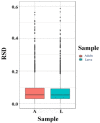Proteomic analysis of Taenia solium cysticercus and adult stages
- PMID: 36699330
- PMCID: PMC9868161
- DOI: 10.3389/fvets.2022.934197
Proteomic analysis of Taenia solium cysticercus and adult stages
Abstract
Taenia solium (T. solium) cysticercosis is a neglected parasitic zoonosis that occurs in developing countries. Since T. solium has a complex life cycle that includes eggs, oncospheres, cysticerci, and adults, presumably many proteins are produced that enable them to survive and establish an infection within the host. The objectives of this study were to perform a comparative proteomic analysis of two ontogenetic stages of T. solium (cysticerci and adult) and to analyze their differential expression of proteins. Methods proteins were separated by High Performance Liquid Chromatography (HPLC) fractionation, and protein samples were also digested in liquid and identified by liquid chromatography tandem mass spectrometry (LC-MS/MS); the differentially expressed proteins were then processed by a bioinformatics analysis and verified by parallel reaction monitoring (PRM). Results we identified 2,481 proteins by label-free quantitative proteomics. Then differentially expressed proteins were screened under P values < 0.05 and 2 fold change, we found that 293 proteins up-regulated and 265 proteins down-regulated. Discussion through the bioinformatics analysis, we analyzed the differences types and functions of proteins in the Taenia solium and cysticercus, the data will provide reference value for studying the pathogenic mechanism of the two stages and the interaction with the host, and also support for further experimental verification.
Keywords: Taenia solium; cysticercus; host-parasite interaction; mass spectrometry proteomic analysis; parallel reaction monitoring.
Copyright © 2023 Li, He, Fan, Liu, Luo, Yang, Jiang, Wang and Zhou.
Conflict of interest statement
The authors declare that the research was conducted in the absence of any commercial or financial relationships that could be construed as a potential conflict of interest.
Figures




Similar articles
-
A gel-free proteomic analysis of Taenia solium and Taenia crassiceps cysticerci vesicular extracts.Parasitol Res. 2018 Dec;117(12):3781-3790. doi: 10.1007/s00436-018-6080-7. Epub 2018 Sep 13. Parasitol Res. 2018. PMID: 30215138
-
[Total protein analysis by two-dimensional electrophoresis in cysticerci of Taenia solium and Taenia asiatica].Zhongguo Ji Sheng Chong Xue Yu Ji Sheng Chong Bing Za Zhi. 2011 Jun;29(3):188-90. Zhongguo Ji Sheng Chong Xue Yu Ji Sheng Chong Bing Za Zhi. 2011. PMID: 21970107 Chinese.
-
Fate of uptaken host proteins in Taenia solium and Taenia crassiceps cysticerci.Biosci Rep. 2018 Jul 6;38(4):BSR20180636. doi: 10.1042/BSR20180636. Print 2018 Aug 31. Biosci Rep. 2018. PMID: 29921579 Free PMC article.
-
Steroid hormone production by parasites: the case of Taenia crassiceps and Taenia solium cysticerci.J Steroid Biochem Mol Biol. 2003 Jun;85(2-5):221-5. doi: 10.1016/s0960-0760(03)00233-4. J Steroid Biochem Mol Biol. 2003. PMID: 12943707 Review.
-
Zoonotic Taenia infections with focus on cysticercosis due to Taenia solium in swine and humans.Res Vet Sci. 2021 Jan;134:69-77. doi: 10.1016/j.rvsc.2020.11.015. Epub 2020 Nov 22. Res Vet Sci. 2021. PMID: 33321377 Review.
Cited by
-
Effect of Hydroxyurea on Morphology, Proliferation, and Protein Expression on Taenia crassiceps WFU Strain.Int J Mol Sci. 2024 May 31;25(11):6061. doi: 10.3390/ijms25116061. Int J Mol Sci. 2024. PMID: 38892261 Free PMC article.
-
Effects of Cysticercus cellulosae Excretory-Secretory Antigens on the TGF-β Signaling Pathway and Th17 Cell Differentiation in Piglets, a Proteomic Analysis.Microorganisms. 2023 Feb 27;11(3):601. doi: 10.3390/microorganisms11030601. Microorganisms. 2023. PMID: 36985175 Free PMC article.
-
Biochemical characterization and gene structure analysis of the 24-kDa glutathione transferase sigma from Taenia solium.FEBS Open Bio. 2024 May;14(5):726-739. doi: 10.1002/2211-5463.13795. Epub 2024 Mar 21. FEBS Open Bio. 2024. PMID: 38514457 Free PMC article.
-
Taenia solium cysticerci's extracellular vesicles Attenuate the AKT/mTORC1 pathway for Alleviating DSS-induced colitis in a murine model.J Extracell Vesicles. 2024 May;13(5):e12448. doi: 10.1002/jev2.12448. J Extracell Vesicles. 2024. PMID: 38779712 Free PMC article.
-
Mass Spectrometry Identifies Taenia solium Proteins in Sera of Patients With and Without Parenchymal Neurocysticercosis.Parasite Immunol. 2024 Jul;46(7):e13058. doi: 10.1111/pim.13058. Parasite Immunol. 2024. PMID: 39072810 Free PMC article.
References
-
- Organization WHO . Neglected tropical diseases: enhancing safe treatment for more than 1 billion people annually. (2021).
LinkOut - more resources
Full Text Sources

